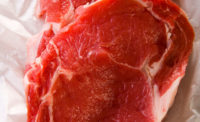Having borrowed my colleague’s crystal ball, I see the following Food Safety and Inspection Service (FSIS) initiatives in 2015:
Labeling
At the time of this writing, FSIS has not issued two final labeling rules. The agency hopes to publish these two in 2014 because, under the Uniform Compliance Date for Labeling Regulations, all labeling regulations published by Dec. 31, 2014, would have an effective date of Jan. 1, 2016. If the agency misses this deadline and publishes the rules on or after Jan. 2, 2015, the effective date for the rules will not be until Jan. 1, 2018.
Mechanically Tenderized Beef — FSIS’ final rule will undoubtedly mandate the addition of a descriptive designation, such as “mechanically tenderized,” on the labels of raw or partially cooked needle- or blade-tenderized beef products, including injected products, intended for either retail or institutional use. FSIS had proposed the designation be part of the product name and that the label bear validated cooking instructions for each product. According to our crystal ball, the designation would need to be prominent, but the other proposed requirements as to the manner of labeling the declaration and specific cooking instructions may modified to provide more flexibility in the final rule.
Product Names for Raw Products Containing Added Solutions— Our crystal ball tells us that FSIS will adopt a disclosure requirement for raw products with solutions. The proposal would have required the disclosure include the percentage of added solution and the individual ingredients/components in the solution, listed in descending order of prominence. A strict reading of the proposal could result in a product name that takes up the entire principal display panel. We expect FSIS will permit greater flexibility in how the disclosure is made, provided the disclosure is adequately conveyed to the consumer.
Pathogens
Salmonella Performance Standards— FSIS will soon publish a Notice in the Federal Register soliciting comments on Salmonella and Campylobacter performance standards for comminuted poultry and chicken parts. FSIS will set the standards to achieve a 25 percent reduction in Salmonellosis to meet the Healthy People 2020 goals. Our crystal ball says to expect these standards to have an acceptable incidence rate of less than 10 percent. To determine compliance, FSIS will move away from sampling “sets” and adopt a continuous sampling model using a moving weekly window. We predict this will be the way FSIS adopts/modifies all Salmonella standards going forward. By the end of 2015, we may see a proposed new standard for ground beef and possibly new performance standards for pork.
Non-O157 STEC— The crystal ball expects that FSIS will expand its analysis of raw ground beef and other raw ground component (including bench trim) samples for the six top non-O157 Shiga-toxin producing E. coli (non-O157 STEC). This would not mean establishments must routinely sample such products for non-O157 STEC. That said, establishments should validate their food safety system is effective for all adulterant STEC and conduct periodic verification sampling.
Slaughter
Sanitary Dressing at Beef Slaughter — We expect FSIS to implement the recommendations made by the Agency Strategic Performance Working Group (SPWG) to improve implementation and verification of sanitary dressing procedures.
Modernization of Poultry Slaughter Inspection— Beginning in February, poultry slaughter establishments can request participation in the New Poultry Inspection System (NPIS). Under NPIS, establishments are responsible for sorting and FSIS conducts a bird-by-bird inspection at the end of the line, just before the chiller. The first plants will likely begin to transition in May. All poultry HIMP plants must convert (as HIMP for poultry disappears when NPIS is implemented).
Looking ahead, 2015 may be a fun-filled, busy year.






Report Abusive Comment